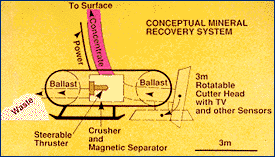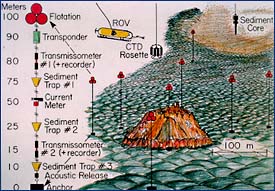Most of the 140 or so known sites are just
geochemical anomalies -- metalliferous sediments, vents with little or no mineralization,
thin crusts, small chimneys and mounds that would fit comfortably inside a small house.
Some, however, are large, such as the main active mound at the Trans-Atlantic Geotraverse
(TAG) site on the mid-Atlantic Ridge east of Miami or the Magic Mountain site on Explorer
Ridge about 200 km west of Vancouver Island. These are comparable in size and shape to
Toronto's Skydome, a covered baseball and football stadium, which makes them to be in the
3 - 5 million metric ton (mmt) range and there are several more large mounds at both
sites. This size is comparable to the typical 1 - 3 million metric ton vms found today on
land in Canada but, of course, nothing at all like the giant Brunswick #12 deposit (134.1
mmt) in New Brunswick or Kidd Creek deposit (117.5 mmt) in Ontario. The
largest of all the ocean vms deposits, the Atlantis II Deep in the Red Sea, is 94 million
metric tons. These metal-rich muds were carefully assessed by the German company Preussag
on behalf of the Sudanese and Saudi Arabian governments in the 1970s. At 0.45% copper,
2.07% zinc, 39 grams/ton silver and 0.5 grams/ton gold, but with higher grade sections,
the deposit was considered to be uneconomic. Regardless, that is a similar grade to the
average for the 85 deposits totaling 1765 million metric tons comprising the Iberian
Pyrite Belt in Spain and Portugal (0.8% Cu, 2.0% Zn, 0.7% Pb, 26 g/t Ag, 0.5 g/t Au).
| Next in size appear to
be the mounds at the Middle Valley site off the west coast of Canada totaling about 25
million metric tons. These mounds are growing in thick sediments and have some attributes
to deposits on land. Recent drilling by the Ocean Drilling Program, of which Canada is a
member has shown that one of mounds contains 220 metres of stacked sulfide lenses
and intervening feeders from which 8 representative samples gave average values of 3.3%
Cu, 19.6% Zn and 0.1% Pb. Beneath is a "Deep Copper Zone" that is about 40
metres thick and is returning copper assays of >10%. |
A wonderous build-up of metals is happening now off Canada's west
coast. Scientists from the Scotiabank Marine Geology Reserch Laboratory at the University
of Toronto have found several mounds of metal sulphides within Canada's 200 nautical mile
economic zone and in the southwest Pacific near Papua New Guinea. The lab continues to
work on the mystery behind the formation of these large deposits. . |
The true grade, in a mining sense, for any of deposits, except for the Atlantis
II Deep, is not known. Most of the sampling has been by submersible and dredge which
typically scrapes the exterior of a mound or takes part of a chimney. These tend to be
quite spectacular. Fifty-nine analyses from TAG, for example, averaged 6.3% Cu, 25.2% Zn,
0.04% Pb, 378 Parts per million (ppm) Ag, 5.7 ppm Au. However, ODP drilling into TAG found
that the interior was mostly relatively barren pyrite and anhydrite. Analyses of the ODP
core average 2.2% Cu, 0.6% Zn, 0.0% Pb, 9 ppm Ag, 0.5 ppm Au. These discouraging results,
from a potential economic point of view, do not seem to have been repeated at Middle
Valley, though. It is probable that, just as is the case for land deposits, some seafloor
vms, like TAG, will be teasers with some high grade parts but mostly low grade while
others will be spectacular.
The eastern Manus Basin (EMB) is an approximately 4000 km2
pull-apart basin between two transform faults in arc crust of New Britain and New Ireland.
Felsic volcanic ridges, mostly dacite and rhyodacite, are surrounded by andesite and
basalt, very reminiscent of the famous Noranda vms district of Archean age.
Basic field work at EMB has consisted of detecting hydrothermal particulate
plumes using an instrument package that was "tow-yoed" between 20 and 300 metres
off bottom behind a ship, deep-tow camera-video traverses and sampling by dredge and
sediment corer. A joint Japanese-French submersible expedition in 1995 on which Roger Moss
and Ray Binns participated conducted detailed mapping and sampling. Extensive zones of
hydrothermally active and dead chimneys, massive sulfides and altered hyaloclastite were
discovered on two large ridges (PACMANUS and SuSu Knolls). The massive sulfides at
PACMANUS, predominantly chimneys without underlying mounds, lie on the flanks of effusive
felsic volcanic domes at a water depth near 1700 metres. Initial analyses of 26 random
samples averaged 10.9% Cu, 26.9% Zn, 1.7% Pb, 230 ppm Ag and 15 ppm Au.
The SuSu site is even better. Here, there is about 5 km strike length of hydrothermal
products and active venting. The main massive sulfide lens (called Suzette) is at a water
depth around 1600 metres. It appears to be about 1200 metres long and 200 - 300 metres
wide but of unknown thickness. Binns' average of 24 analyses of 15% Cu, 2% Zn, 130 ppm Ag
and 21 ppm Au is rather spectacular. That these deposits are so very gold rich should not
be surprising when it is considered that EMB lies within a gold metallogenic province that
stretches some 25,000 km from Kyushu, Japan (e.g., Hishikari gold mine) to the Taupo Zone
of North Island, New Zealand. The very gold-rich Lihir Island deposit is just a stone's
throw to the east of EMB on the other side of New Ireland.
|
|
It is
these spectacular analyses and potentially large tonnage that attracted Nautilus Minerals
to the EMB area. They now hold an exclusive exploration license from the Papua New Guinea
government. Will they be able to do the first seafloor mining of a vms here? Maybe.
Nautilus is dealing with permitting from a single friendly government, instead of the UN
if the site had been in international waters and, being in the ocean, there will be no
competing land claims from special interest groups as commonly happens on land. The
environmental consequences of ocean mining may be less deleterious than land mining. There
will be no acid mine waters to contend with because sea water, being alkaline, would
neutralize any acids that may form and submarine weathering is a very slow process in any
case. There will be no gaping holes on the sea bed and no huge rock piles; the deposits
are sitting on the sea floor uncovered. Besides, it would be technically difficult and
very expensive to excavate in lavas compared with extracting rather crumbly, poorly
consolidated polymetallic sulfides. Some fauna are bound to be killed but a competent
biological assessment prior to mining can determine whether or not this would lead to
species extinction. |
The technology for extracting bulk samples from
the sea floor does not yet exist in total but some engineering can be borrowed from the
ill fated manganese nodule programs of the 1970s. The Japanese are developing an ocean
miner which is said could be used both for manganese nodules and polymetallic sulfides.
Actually, polymetallic sulfide recovery from the rather shallow seabed at EMB should be
easier than for manganese nodules where depths are on the order of 5500 metres. The
Japanese may be in a position to try out their new miner on a vms deposit of their own.
Their Metal Mining Agency has recently announced that they have begun a 5 year feasibility
study of a large deposit they have found in the Okinawa Trough at about 1600 metres water
depth between Taiwan and Kyushu.
Return to Future Mining Menu

